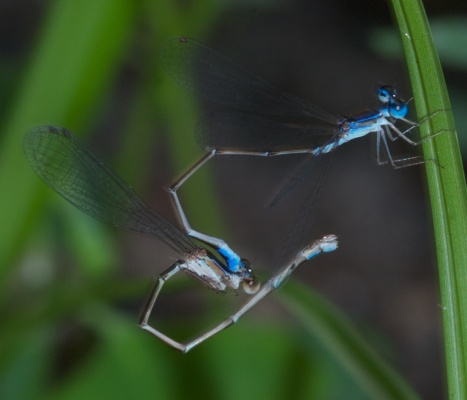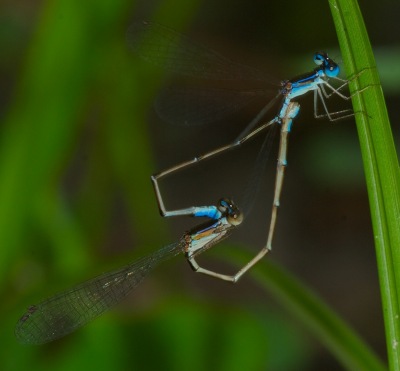After my post a couple of weeks ago where I lost track of a pair of damselflies in tandem before I found out whether they actually attained the wheel position I’ve been hoping for another chance. Today, the first sunny day after what seems like a week of rain, I got my wish. In spades! This evening there were more Nehalennia pallidula than I could shake a stick at! Everywhere I looked was a male looking for a mate, a pair that I accidentally separated with my clumsy walking through the tall grass, or a pair actually mating!
I managed to latch onto one pair that seemed to know which end was up, and I was able to follow them without scaring them to separate. I even managed a few “in-process” pictures.
Here is one of the puzzles from last time; I simply couldn’t figure out how the male grabs onto the female and THEN transfers the sperm from his primary genitalia at the tip of the abdomen to his secondary genitalia on segment two. Well, here is how he does it:
Once the sperm transfer is complete, the male then induces the female to curl her abdomen up, as seen in the blurry image below:
And then they are able to complete the wheel position. (Yes, many commentators have pointed out that this looks more like a heart than a wheel. Biologists don’t care.)
This species may not be abundant in the wild*, but in the urban wilderness of my property, I would guesstimate, just ticking them off on my fingers, that there were at least two dozen individuals today: 8 in the tall grass behind the shed, 5 or 6 more under the canoe, at least 6 more in the front yard, and probably 10 more on the other side. These are conservative guesstimates. These numbers are just for the Everglades Sprite; I didn’t even mention (until now) the Fragile Forktail or two that I saw, or the Rambur’s Forktail pair I saw mating earlier today.
Don’t know where all the Citrine Forktails have gone (a month ago they were present in numbers similar to those of the Everglades Sprite today), but their position in the ecosystem has not gone unfilled!
Spring may be almost over, but it sure is still la saison d’amour here in my yard! Go odonata!
*I know no one ever clicks links anymore, so I’ll just tell you that its status is “Near Threatened” on the IUCN Red List for 2011.2.



